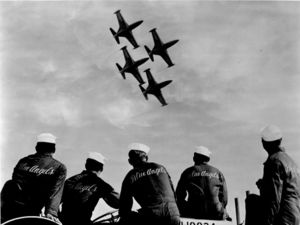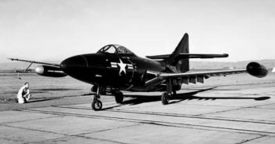PlaneSpottingWorld welcomes all new members! Please gives your ideas at the Terminal.
F9F Panther
| Grumman F9F Panther | |
|---|---|
| Type | Fighter-bomber |
| Manufacturer | Grumman Aircraft Engineering Corporation |
| Maiden flight | 24 November 1947 |
| Retired | 1958, U.S. Navy 1969, Argentina |
| Primary users | United States Navy United States Marine Corps Argentine Navy |
| Variants | F9F Cougar |
The Grumman F9F Panther was the manufacturer's first jet fighter and the U.S. Navy's second. The Panther was the most widely used U.S. Navy jet fighter of the Korean War. It flew 78,000 sorties and was responsible for the first air kill in the war—the downing of a North Korean Yakovlev Yak-9 fighter. Total F9F production was 1,382, with several variants being shipped to Argentina for export.
Contents
Design and development
Development studies at the Grumman company began near the end of the World War II as the first jet engines emerged. The prototype Panther, piloted by test pilot Corky Meyer, first flew on 24 November 1947.[1] Propulsion was a Rolls-Royce Nene turbojet built under license by Pratt & Whitney as the J42. Since there was insufficient space within the wings and fuselage for fuel for the thirsty jet, permanently-mounted wingtip fuel tanks were added which incidentally improved the fighter's rate of roll.[2]It was cleared for flight from aircraft carriers in September 1949. During the development phase, Grumman decided to change the Panther's engine, selecting the Pratt & Whitney J48-P-2, a license built version of the Rolls-Royce Tay. The other engine that had been tested was the Allison J33-A-16, a development of the Rolls-Royce Derwent.[3]
US Operational service
F9F-2s, F9F-3s and F9F-5s served with distinction in the Korean War, downing two Yak-9s and five Mikoyan-Gurevich MiG-15s with a loss of one F9F. On 3 July 1950, LTJG Leonard H. Plog of U.S. Navy's VF-51 flying an F9F-3 scored the first air victory of the war by shooting down a Yak-9. The first MiG-15 downed was on 9 November 1950 by U.S. Navy Lieutenant Commander William (Bill) Amen of VF-111 "Sundownders" Squadron flying an F9F-2B. Two more were downed on 18 November 1950 , and the other two were downed on the 18 November 1952.[4] The type was the primary Navy jet fighter and ground-attack plane in the Korean conflict.
Panthers were withdrawn from front-line service in 1956, but remained in training roles and with Reserve units until 1958, some continuing to serve in small numbers into the 1960s.[5]
Foreign service
The only foreign buyer of the Panther was the Argentine Navy, who bought 24 ex-USN aircraft in 1958. The catapults on the then only Argentine carrier, ARA Independencia (V-1), were considered not powerful enough to launch the F9F, so the aircraft were land-based.
The Argentine Panthers were involved in the general mobilization during the 1965 border clash between Argentina and Chile but no combat occurred. They were taken out of service in 1969 due to the lack of spare parts and replaced with A-4Q Skyhawks.
Variants

- XF9F-2: the first two prototypes
- XF9F-3: the third prototype
- F9F-2: first production version, J42 powered.
- F9F-2B: version fitted with underwing racks for bombs and rockets. All F9F-2s were eventually so modified, and the B designation was dropped.
- F9F-2P: unarmed photographic reconnaissance version used in Korea
- F9F-3: Allison J33 powered version produced as insurance against the failure of the J42, 54 built. All converted to J42 power later
- XF9F-4: Prototype used in the development of the F9F-4.
- F9F-4: longer fuselage with greater fuel load, J33 powered. Most re-engined with J42s. F9F-4s were the first aircraft to successfully employ blown air, extracted from between the engine´s compressor and combustion chambers, to energise the slot flaps, thus achieving a decrease in stalling speed of 9kt for takeoff and 7kt on power approach for landing.
- F9F-5: As -4, but Pratt & Whitney J48-powered. 616 built.
- F9F-5P: unarmed photo-reconnaissance version, 36 built, longer nose.
- F9F-5KD: After the F9F Panther was withdrawn operational service, a number of F9F-5s were converted into unmanned target drone aircraft. Redesignated DF-9E in 1962.
Continued development
From 1946, a swept-wing version was considered and after concerns about the Panther's inferiority to its MiG opponents in Korea, a conversion of the Panther (Design 93) resulted in a swept-wing derivative of the Panther, the Grumman F9F Cougar, which retained the Panther's designation number.[7]
The Panther in film
The Panther played a prominent role in the 1954 movie Men of the Fighting Lady. It was also used for the flying sequences in the 1955 movie The Bridges at Toko-Ri, although in the 1953 James A. Michener novel upon which the movie was based, the main character flew an F2H Banshee, not a Panther.
Operators
Specifications (F9F-2 Panther)
Data from [citation needed]
General characteristics
- Crew: 1
- Length: 37 ft 5 in (11.3 m)
- Wingspan: 38 ft 0 in (11.6 m)
- Height: 11 ft 4 in (3.8 m)
- Wing area: 250 ft² (23 m²)
- Empty weight: 9,303 lb (4,220 kg)
- Loaded weight: 14,235 lb (6,456 kg)
- Max takeoff weight: 16,450 lb (7,462 kg)
- Powerplant: 1× Pratt & Whitney J42-P-6/P-8 turbojet, 5,950 lbf (26.5 kN) with water injection
Performance
- Maximum speed: 500 knots (575 mph, 925 km/h)
- Range: 1,300 mi (1,100 nm, 2,100 km)
- Service ceiling: 44,600 ft (13,600 m)
- Rate of climb: 5,140 ft/min (26.1 m/s)
- Wing loading: 71 lb/ft² (350 kg/m²)
- Thrust/weight: 0.42
Armament
- Guns: 4× 20 mm (0.787 in) M2 cannon, 190 rounds/gun
- Hardpoints: Underwing hardpoints with provisions to carry combinations of:
- Rockets: 6× 5 in (127 mm) rockets on underwing hardpoints
- Bombs: 2,000 lb (910 kg) of bombs
References
- Grossnick, Roy and Armstrong William J. United States Naval Aviation, 1910-1995. Annapolis: Naval Historical Center, 1997. ISBN 0-16049-124-X.
- Meyer, Corwin H. Grumman Panther, "Flight Journal, Oct. 2002."
- Sullivan, Jim. F9F Panther/Cougar in action. Carrollton, Texas: Squadron/Signal Publications, 1982. ISBN 0-89747-127-X.
- Taylor, John W.R. Grumman F9F Couger. "Combat Aircraft of the World from 1909 to the present." New York: G.P. Putnam's Sons, 1969. ISBN 0-425-03633-2.
- Taylor, John W.R. Grumman F9F Panther. "Combat Aircraft of the World from 1909 to the present." New York: G.P. Putnam's Sons, 1969. ISBN 0-425-03633-2.
- Winchester, Jim. Gruman F9F Panther. "Aircraft of World War II." Rochester, UK: Grange Books plc, 2004. ISBN 1-84013-639-1.
Related content
Related development
Comparable aircraft
Designation sequence
| F9F Panther | - XF10F - F11F - F12F | |
| F9F Cougar |
| F-9 Panther | - F-10 - F-11 - YF-12 | |
| F-9 Cougar |
Related lists
- List of fighter aircraft
- List of military aircraft of the United States
- List of military aircraft of the United States (naval)
Lists relating to aviation | |
|---|---|
| General | Timeline of aviation · Aircraft · Aircraft manufacturers · Aircraft engines · Aircraft engine manufacturers · Airports · Airlines |
| Military | Air forces · Aircraft weapons · Missiles · Unmanned aerial vehicles (UAVs) · Experimental aircraft |
| Notable incidents and accidents | Military aviation · Airliners · General aviation · Famous aviation-related deaths |
| Records | Flight airspeed record · Flight distance record · Flight altitude record · Flight endurance record · Most produced aircraft |
fr:Grumman F9F Panther it:Grumman F9F Panther no:Grumman F9F Panther pl:Grumman F9F Panther

